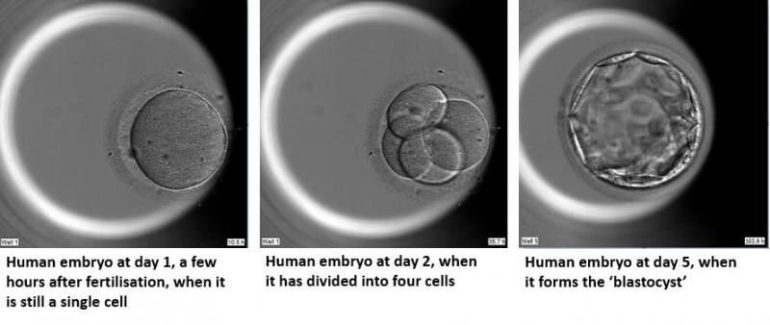Researchers at the Francis Crick Institute have revealed that CRISPR-Cas9 genome editing can lead to unintended mutations at the targeted section of DNA in early human embryos. The work highlights the need for greater awareness of and further research into the effects of CRISPR-Cas9 genome editing, especially when used to edit human DNA in laboratory research.
CRISPR-Cas9 genome editing is a widely used research tool which allows scientists to remove and replace sections of DNA in cells, allowing them, for example, to study the function of a given gene or to repair mutations. Last year, the researchers who developed CRISPR-Cas9 were awarded the Nobel Prize in Chemistry.
In their study, published in PNAS, Crick scientists retrospectively analyzed data from previous research where they had been studying the role of the OCT4 protein in human embryos during the first few days of development.
The team found that while the majority of CRISPR-Cas9-induced mutations were small insertions or deletions, in approximately 16% of samples there were large unintended mutations that would have been missed by conventional methods to assess DNA changes.
Research is ongoing to understand the exact nature of the changes at the target sites but this could include deletions of sections of DNA or more complex genomic rearrangements.
The discovery highlights the need for researchers who use CRISPR-Cas9-mediated genome editing to edit human cells, whether somatic or germline, to be aware of and test for these potential unintended consequences. This is even more essential if they hope their work will be used clinically, as unintended genetic changes like this could lead to diseases like cancer.
“Other research teams have reported these types of unintended mutations in human stem cells, cancer cells and other cellular contexts, and now we’ve detected them in human embryos,” says Professor Kathy Niakan, group leader of the Human Embryo and Stem Cell Laboratory at the Francis Crick Institute and Professor of Reproductive Physiology at the University of Cambridge, and senior author of the study.
“This work underscores the importance of testing for these unintended mutations to understand exactly what changes have happened in any human cell type.”
The Crick researchers have developed an open-source computational pipeline to identify whether CRISPR-Cas9 has caused unintended on-target mutations based on different types of next-generation sequencing data.
“We and others are trying to develop and refine the tools to assess these complex mutations, ” added Niakan.
“It is important to understand these events, how they arise and their frequency, so we can appreciate the current limitations of the technology and inform strategies to improve it in the future to minimize these mutations.”
Gregorio Alanis-Lobato, lead author and a former postdoctoral training fellow in the Human Embryo and Stem Cell Laboratory at the Crick, says: “Conventional tests used to check the accuracy of CRISPR-Cas9 can miss the types of unintended on-target mutations we identified in this study. There’s still so much for us to learn about the effects of CRISPR-Cas9 technology and while this valuable tool is refined, we need to thoroughly examine all changes.”
There are important ongoing debates around the safety and ethics of using CRISPR-Cas9 genome editing on human embryos for reproductive purposes. And in 2019, there was international condemnation of the work of a researcher in China who edited embryos which led to the birth of twins. In the UK, its use on human embryos is closely regulated and is only allowed for research purposes. Research is restricted to the first 14 days of development and embryos are not allowed to be implanted into a womb.
The data for this work related to embryos previously studied by the Crick’s Human Embryo and Stem Cell Laboratory. The embryos were at the blastocyst stage of early development, consisting of around 200 cells. They had been donated to research by people undergoing in vitro fertilization (IVF) and were not needed during the course of their treatment.
The research was led by scientists at the Francis Crick Institute, in collaboration with colleague Professor Dagan Wells at the University of Oxford. Kathy Niakan is incoming Director of the University of Cambridge’s Centre for Trophoblast Research, and Chair of the Cambridge Strategic Research Initiative in Reproduction.
Study identifies pitfall for correcting mutations in human embryos with CRISPR
More information:
Frequent loss-of-heterozygosity in CRISPR-Cas9–edited early human embryos PNAS, doi.org/10.1073/pnas.2004832117
Provided by
The Francis Crick Institute
Citation:
Researchers call for greater awareness of unintended consequences of CRISPR gene editing (2021, April 12)
retrieved 12 April 2021
from https://phys.org/news/2021-04-greater-awareness-unintended-consequences-crispr.html
This document is subject to copyright. Apart from any fair dealing for the purpose of private study or research, no
part may be reproduced without the written permission. The content is provided for information purposes only.
